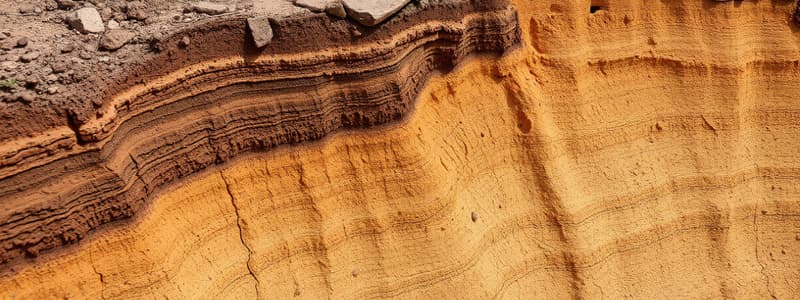Podcast
Questions and Answers
What best defines erosion?
What best defines erosion?
- The process of planting vegetation to improve soil quality.
- The chemical alteration of soil due to environmental factors.
- The accumulation of sediment in a specific area over time.
- The process of wearing away and transporting materials from one location to another. (correct)
Which of the following is NOT a cause of erosion?
Which of the following is NOT a cause of erosion?
- Glacial movement
- Soil enrichment techniques (correct)
- Urban development
- Deforestation
Which type of erosion is specifically associated with the action of rainfall?
Which type of erosion is specifically associated with the action of rainfall?
- Water erosion (correct)
- Chemical erosion
- Wind erosion
- Glacial erosion
What impact does erosion have on agriculture?
What impact does erosion have on agriculture?
Which method is NOT used for the prevention and control of erosion?
Which method is NOT used for the prevention and control of erosion?
Flashcards are hidden until you start studying
Study Notes
Definition of Erosion
-
Erosion: The process of wearing away and removing soil, rock, or other surface material from one location and transporting it to another.
-
Causes of Erosion:
- Natural Factors: Wind, water (rivers, rain, and ocean waves), ice (glaciers).
- Human Activities: Deforestation, agriculture, urban development, and mining.
-
Types of Erosion:
- Water Erosion: Caused by rainfall, runoff, and river flow.
- Types: Sheet erosion, rill erosion, gully erosion.
- Wind Erosion: Occurs in dry, loose soils where wind lifts and transports particles.
- Glacial Erosion: Movement of glaciers scraping and eroding the landscape beneath them.
- Water Erosion: Caused by rainfall, runoff, and river flow.
-
Impact of Erosion:
- Loss of fertile topsoil, affecting agriculture.
- Alteration of landscapes, leading to changes in ecosystems.
- Increased sedimentation in rivers and lakes, impacting water quality and habitats.
-
Prevention and Control:
- Vegetative cover (plants and trees) to anchor soil.
- Terracing and contour farming to reduce runoff.
- Use of erosion control blankets and silt fences in construction areas.
Definition of Erosion
- Erosion is the process of wearing away and transporting soil, rock, or surface material from one location to another.
Causes of Erosion
- Natural factors contributing to erosion include wind, water (from rivers, rainfall, and ocean waves), and ice (such as glaciers).
- Human activities that accelerate erosion encompass deforestation, agriculture, urban development, and mining.
Types of Erosion
- Water erosion is primarily triggered by rainfall, runoff, and river flow, with subtypes including:
- Sheet erosion: Thin layers of topsoil are removed uniformly.
- Rill erosion: Small channels form as runoff concentrates.
- Gully erosion: Deep, wide channels develop due to substantial water flow.
- Wind erosion typically occurs in dry and loose soils, where strong winds lift and transport soil particles.
- Glacial erosion involves the movement of glaciers that scrape and reshape the underlying landscape.
Impact of Erosion
- Erosion leads to the loss of fertile topsoil, which is crucial for agriculture.
- It alters landscapes, leading to ecological changes and habitat disruption.
- Increased sedimentation in rivers and lakes degrades water quality and affects aquatic habitats.
Prevention and Control
- Vegetative cover, including plants and trees, plays a vital role in anchoring soil and preventing erosion.
- Techniques like terracing and contour farming are used to minimize runoff on agricultural lands.
- Construction sites can utilize erosion control blankets and silt fences to mitigate soil loss.
Studying That Suits You
Use AI to generate personalized quizzes and flashcards to suit your learning preferences.



